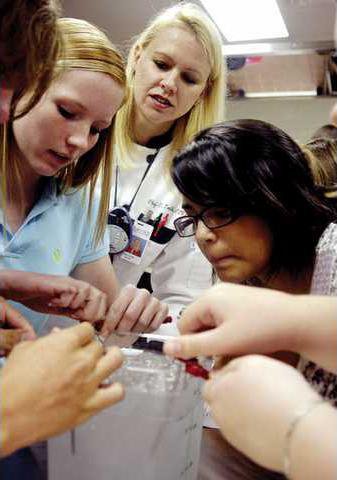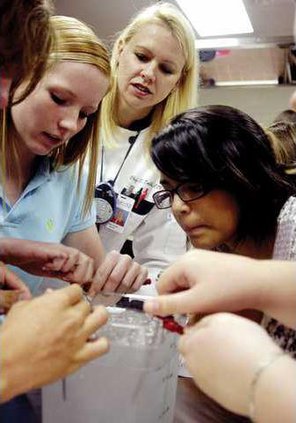West Forsyth High School’s new culinary arts teacher sometimes compares teaching young people to cook to starting a recipe from scratch.
“It’s exciting teaching young students to cook because some of these kids don’t know anything yet,” said Chef Dee Smith.
“I can teach them the perfect techniques for safety and sanitation, and it can set them on the path to be really great workers and future employees.”
Dawn Martin, South Forsyth High School’s culinary arts teacher, agrees.
“A lot of students come into the class not knowing how to sweep or mop,” Martin said. “We teach them the basics.”
Martin touted the success of West Forsyth’s new culinary arts program. Prior to the start of West’s program this semester, South had the only culinary arts offering in the school district.
Smith said with the addition of the program at West, she and Martin will pose a double threat to opponents in upcoming cooking competitions.
“In the past, my culinary team has ranked top three in the state,” said Smith, who taught for eight years with Marietta City Schools. She said South has also placed in the top three.
“Dawn’s a great teacher,” she said. “We’re twin powerhouses up here in Forsyth County. We’re gonna put it on the map.”
Smith said she has already seen much interest in a potential culinary team that could form in November.
“I had students approach me the second day of school telling me they’ll do what it takes to make the culinary team,” Smith said.
Martin said a competition could be in the works for the schools.
“We’re both competitive,” Martin said, “and we both hate to lose.”
South Forsyth sophomore Rebecca Sivak said she plans to try out for the team this year. Tryouts are set for November at South and West.
“A lot of people pick this class because you get free food during school,” she said. “I wasn’t that interested in cooking until I started taking this class.”
Now Sivak cooks for her entire family, who she said has no complaints.
“I do most of the cooking around my house,” she said, adding that she has plans to be a food critic one day.
Smith said she plays the role of food critic in her classroom when grading students.
“They get graded on taste, texture and appearance,” she said. “These are all important in preparing students for the real thing.”
Both teachers agreed that the classes prepare their students for the work force.
“People go out to eat a lot,” Smith said, “so there’s always a need for jobs in the industry.
“This is not a program to train line cooks,” she continued. “We’re beyond biscuits here. This class trains students to go into a post secondary institution or right into management-level trainee jobs.”
West Forsyth senior Jason Klanac said he could see himself pursuing a career in the hospitality industry.
“It’s a good skill to have, knowing how to cook,” Klanac said, adding that West Forsyth’s new kitchen is “state of the art.”
“I’ve worked at a restaurant before,” he said. “It didn’t have anything like the stuff we’ve got in our kitchen. There’s some nice equipment here.”
Students at West are currently learning knife skills.
“They’re learning all the classic cuts,” Smith said. “After that, they’ll start baking and learning the basics like how to whisk properly and how to saute. If you teach them the basics correctly, they can pick up a recipe and learn how to cook anything.”
Cooking and cooking preparation make up the bulk of classwork, but other lessons, like individual pace, come into play.
“The restaurant business is very fast-paced,” Martin said.
“When we tell these students to hurry, hurry, hurry, sometimes they think we’re picking on them. But it’s an important part of the business.”
Still, Martin said the classroom environment differs in some ways from that of the workplace.
“In a restaurant you do not have much room to work with,” she said. “But in a classroom with 28 students you’ve got to make sure they’ve got enough room. Our equipment is spaced apart a little bit because there are safety concerns that are a little different with students than in the real industry.”
Smith said just because one program is at West and the other is at South doesn’t mean there’s a rivalry brewing.
“I give Dawn ideas, she gives me ideas. We complement each other very well.”
“It’s exciting teaching young students to cook because some of these kids don’t know anything yet,” said Chef Dee Smith.
“I can teach them the perfect techniques for safety and sanitation, and it can set them on the path to be really great workers and future employees.”
Dawn Martin, South Forsyth High School’s culinary arts teacher, agrees.
“A lot of students come into the class not knowing how to sweep or mop,” Martin said. “We teach them the basics.”
Martin touted the success of West Forsyth’s new culinary arts program. Prior to the start of West’s program this semester, South had the only culinary arts offering in the school district.
Smith said with the addition of the program at West, she and Martin will pose a double threat to opponents in upcoming cooking competitions.
“In the past, my culinary team has ranked top three in the state,” said Smith, who taught for eight years with Marietta City Schools. She said South has also placed in the top three.
“Dawn’s a great teacher,” she said. “We’re twin powerhouses up here in Forsyth County. We’re gonna put it on the map.”
Smith said she has already seen much interest in a potential culinary team that could form in November.
“I had students approach me the second day of school telling me they’ll do what it takes to make the culinary team,” Smith said.
Martin said a competition could be in the works for the schools.
“We’re both competitive,” Martin said, “and we both hate to lose.”
South Forsyth sophomore Rebecca Sivak said she plans to try out for the team this year. Tryouts are set for November at South and West.
“A lot of people pick this class because you get free food during school,” she said. “I wasn’t that interested in cooking until I started taking this class.”
Now Sivak cooks for her entire family, who she said has no complaints.
“I do most of the cooking around my house,” she said, adding that she has plans to be a food critic one day.
Smith said she plays the role of food critic in her classroom when grading students.
“They get graded on taste, texture and appearance,” she said. “These are all important in preparing students for the real thing.”
Both teachers agreed that the classes prepare their students for the work force.
“People go out to eat a lot,” Smith said, “so there’s always a need for jobs in the industry.
“This is not a program to train line cooks,” she continued. “We’re beyond biscuits here. This class trains students to go into a post secondary institution or right into management-level trainee jobs.”
West Forsyth senior Jason Klanac said he could see himself pursuing a career in the hospitality industry.
“It’s a good skill to have, knowing how to cook,” Klanac said, adding that West Forsyth’s new kitchen is “state of the art.”
“I’ve worked at a restaurant before,” he said. “It didn’t have anything like the stuff we’ve got in our kitchen. There’s some nice equipment here.”
Students at West are currently learning knife skills.
“They’re learning all the classic cuts,” Smith said. “After that, they’ll start baking and learning the basics like how to whisk properly and how to saute. If you teach them the basics correctly, they can pick up a recipe and learn how to cook anything.”
Cooking and cooking preparation make up the bulk of classwork, but other lessons, like individual pace, come into play.
“The restaurant business is very fast-paced,” Martin said.
“When we tell these students to hurry, hurry, hurry, sometimes they think we’re picking on them. But it’s an important part of the business.”
Still, Martin said the classroom environment differs in some ways from that of the workplace.
“In a restaurant you do not have much room to work with,” she said. “But in a classroom with 28 students you’ve got to make sure they’ve got enough room. Our equipment is spaced apart a little bit because there are safety concerns that are a little different with students than in the real industry.”
Smith said just because one program is at West and the other is at South doesn’t mean there’s a rivalry brewing.
“I give Dawn ideas, she gives me ideas. We complement each other very well.”

